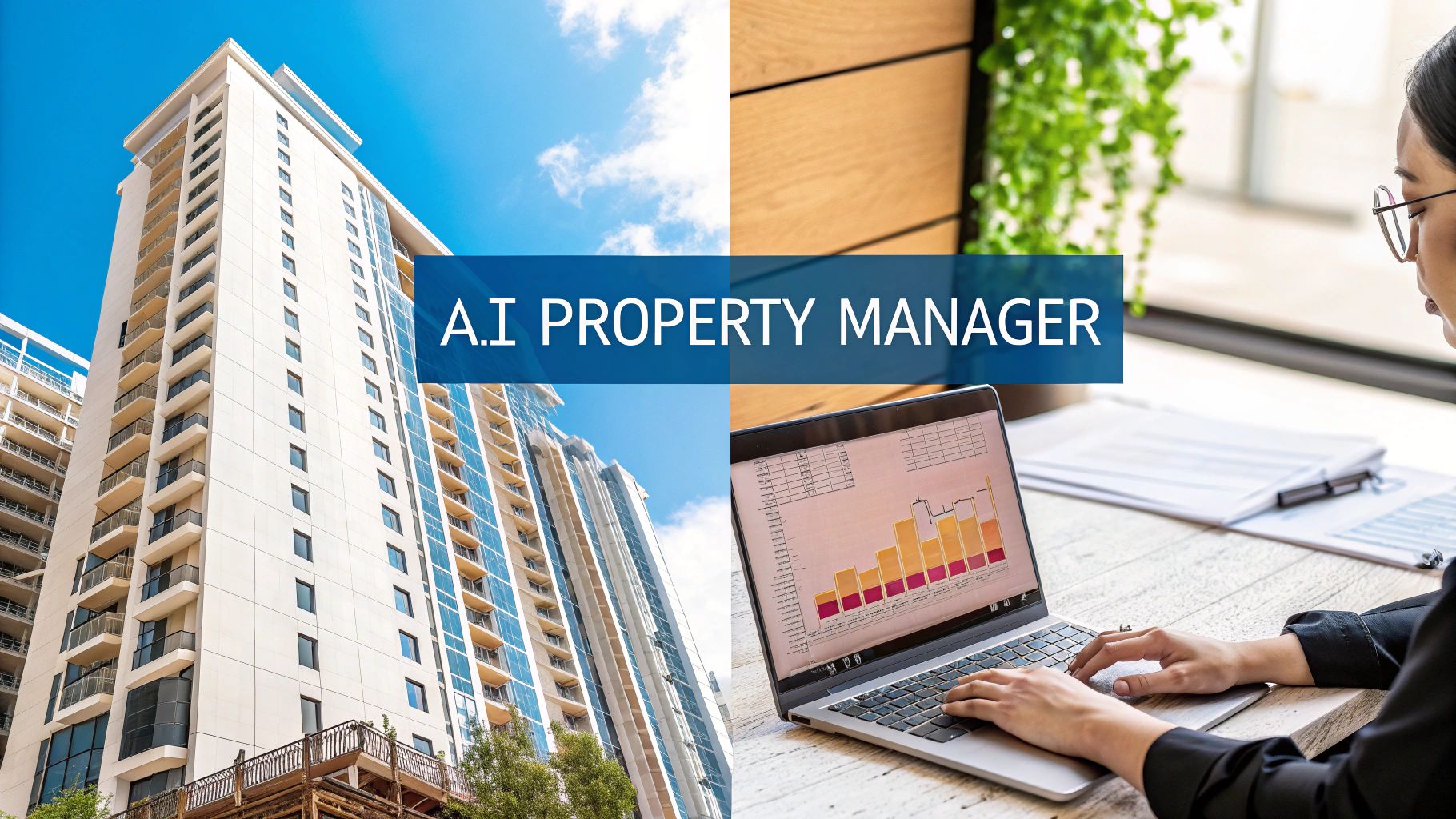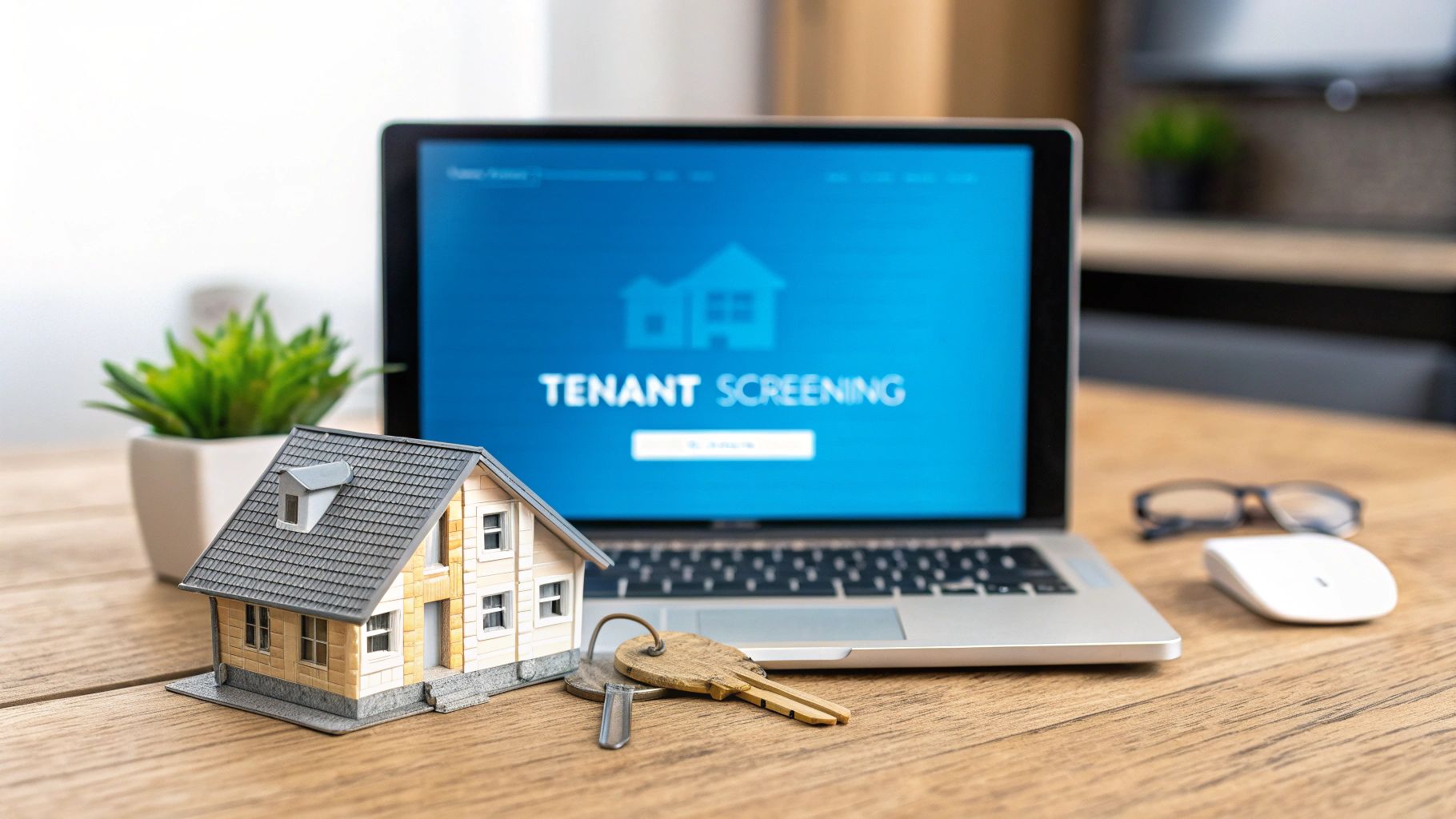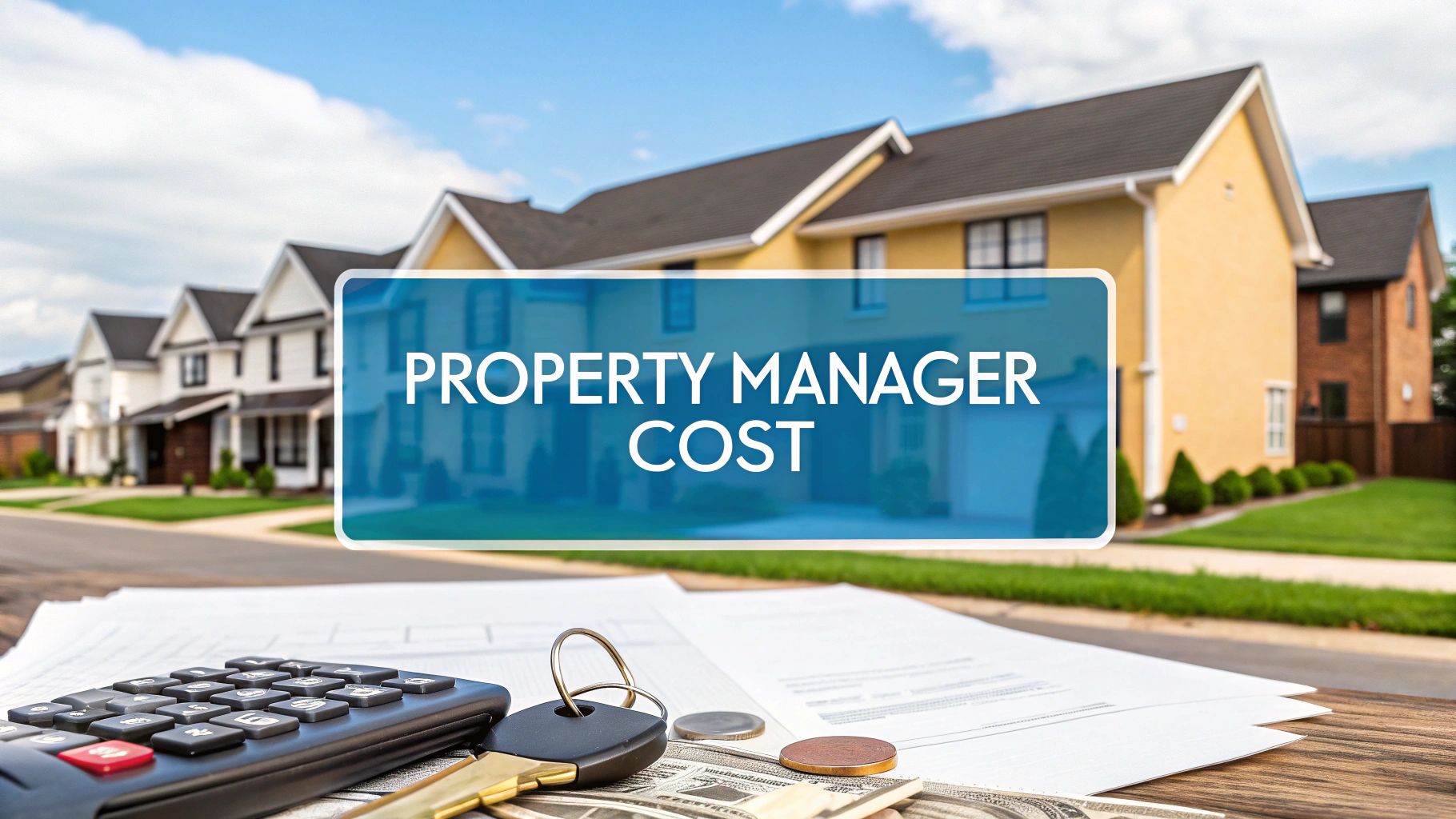For large-scale property management companies, operational success hinges on two critical metrics: Days on Market (DOM) and lead-to-tour conversion rates. When managing 1,000 to 10,000+ units across a distributed portfolio, manual processes create bottlenecks, inflate vacancy costs, and limit scalability. This is where AI property management becomes a strategic imperative, transforming your operations from reactive fire-fighting to proactive portfolio optimization.
The New Reality of Managing Large Property Portfolios

Managing a scattered portfolio of 1,000, 5,000, or even 10,000 units is a game of speed and efficiency. Every day a unit sits vacant, it directly erodes your revenue. The primary challenge for enterprise operators isn't just generating leads; it's converting qualified prospects into signed leases faster than the competition, especially when operating remotely without onsite staff at every location.
This is precisely why AI is no longer a "nice-to-have" but a core component of the modern operational framework for property management at scale. It isn't about replacing experienced team members; it’s about equipping them with intelligent automation to handle the repetitive, time-consuming tasks that hinder growth and drive up the cost per door.
From Manual Drag to Automated Speed
Consider the typical leasing scenario. A high-intent lead submits an inquiry on a Friday evening. Your leasing team, already managing a heavy workload, may not see it until Monday morning. By then, that motivated renter has already toured three competing properties and is off the market.
AI-driven systems eliminate this costly delay. Operating 24/7, they engage, qualify, and schedule tours the moment a lead shows interest. For large portfolios, this obsession with speed-to-lease is paramount.
The core function of AI in leasing is to dramatically shrink the time between a prospect’s initial click and the moment they step inside a property. By automating the top of your leasing funnel, you empower your team to focus on high-value activities: building relationships, negotiating leases, and enhancing the resident experience—not drowning in an administrative backlog.
A Market That's Hitting Its Stride
The industry is adopting this technology rapidly. The AI in real estate market was valued at around USD 303 billion in 2025 and is projected to skyrocket to nearly USD 988.59 billion by 2029. That’s a compound annual growth rate of 34.4%. You can dig into the specifics in the full research about AI in the real estate market. This explosive growth is driven by one simple fact: AI delivers proven workflow automation and superior market insights.
This isn't just a trend; it's a significant competitive advantage. Property managers who leverage AI are realizing tangible, measurable results:
- Drastic DOM Reduction: By enabling same-day showings as a standard practice, AI tools significantly reduce vacancy periods, directly impacting NOI.
- Higher Lead-to-Tour Conversion: Instant, persistent automated follow-up ensures no qualified lead is ever missed, a critical factor for improving key conversion metrics.
- Standardized Operations: AI ensures every lead, regardless of the property or market, receives the same high-quality, efficient experience, enforcing consistency across a multi-market portfolio.
AI's Impact on Key Enterprise Property Management Metrics
To put it in perspective, here’s a quick look at how AI directly addresses the biggest challenges that come with managing a large, distributed portfolio.
Ultimately, AI allows enterprise-level operators to move faster, work smarter, and scale their business without being held back by the limitations of manual processes.
Understanding the AI Tools Driving Modern Property Management

To effectively leverage AI property management across a large portfolio, it's essential to understand the core technologies that solve real-world operational bottlenecks. This isn't about becoming a data scientist; it's about knowing which tools in your arsenal can drive efficiency and scale.
Think of these technologies as a team of specialized digital employees, each with a unique skill set. Their adoption is fueling massive industry growth, with the global property management market projected to grow from USD 23.03 billion in 2025 to nearly USD 38.48 billion by 2034. This growth is centered on using AI to meet rising operational demands, a trend you can explore in this property management market research.
Three key AI components work in concert to automate and optimize your leasing funnel.
Machine Learning: The Predictive Market Analyst
Imagine having a tireless analyst who can sift through years of your portfolio's leasing data—plus current market trends—in seconds. That's machine learning (ML). For enterprise-level property managers, ML models are trained to identify patterns that are impossible for humans to spot across thousands of units.
- Predictive Pricing: ML algorithms analyze comps, seasonality, and local demand to recommend optimal rental prices, aiming to minimize Days on Market (DOM) while maximizing revenue.
- Vacancy Forecasting: By identifying factors that lead to longer vacancies—such as specific unit features or historical market dips—ML can flag at-risk properties before they impact your bottom line.
- Lead Scoring: The system learns to identify which leads are most likely to convert into signed leases, allowing your team to prioritize follow-up efforts on the highest-intent prospects first.
Natural Language Processing: The 24/7 Leasing Assistant
Every missed call or delayed email response is a potential lost lease. Natural Language Processing (NLP) is the technology that prevents this from happening. It’s the brain behind AI chatbots and automated communication systems that can understand and respond to human language.
For a large, distributed portfolio, an NLP-powered assistant becomes your frontline for lead management.
It works around the clock to instantly answer common questions ("Do you allow pets?"), pre-qualify prospects based on your criteria, and schedule showings directly into your team’s calendar. This one function is a game-changer for lead-to-tour conversion, ensuring you engage every prospect at the peak of their interest.
This automation frees your human agents from the high-volume, low-complexity task of initial lead response. Instead, they can focus on high-value interactions like conducting great tours and negotiating leases.
Computer Vision: The Eyes on the Ground
For portfolios spread across different cities—especially those with SFRs or multifamily buildings without onsite staff—providing timely property access is a significant operational challenge. Computer Vision addresses this by enabling smart, secure self-showings.
This technology allows AI systems to "see" and interpret the physical world. In property management, this translates to:
- Smart Lock Integration: AI can verify a prospect's identity and grant them temporary, secure access for a self-guided tour.
- Virtual Tour Enhancements: It powers the immersive 3D tours that allow prospective tenants to explore a property from anywhere, massively widening your applicant pool.
- Property Condition Monitoring: In advanced applications, computer vision can help document a property's condition before and after a tour, adding a layer of security and accountability.
When combined, these technologies create a powerful, seamless system. A prospect finds your listing, interacts with an NLP assistant to get qualified and scheduled, and then uses a computer vision-enabled smart lock to tour the unit—all driven by ML insights that priced it perfectly from the start. You can check out a curated list of the best AI-powered property management tools to see how different platforms bundle these capabilities.
How AI Directly Reduces Vacancy and Boosts Revenue

For any enterprise portfolio, discussions about new technology inevitably circle back to one critical question: what is the direct impact on revenue? This is where AI property management demonstrates its most compelling value. It directly attacks the single biggest drain on your NOI: vacancy.
At its core, an AI-powered system is engineered to shrink the leasing timeline at every stage, turning a prospect's initial interest into a signed lease with maximum velocity.
This is about re-engineering the leasing funnel for an on-demand world. Today's renters expect instant answers and same-day showings. AI-driven scheduling and communication tools deliver precisely that, operating 24/7 so no lead goes cold—a massive advantage for multi-market property management.
Accelerating Speed-to-Lease with Intelligent Automation
The journey from a new lead to a signed lease is a race against time. An AI system acts as your pace car, setting a tempo that manual processes cannot match. It achieves this through a series of automated actions all aimed at one goal: slashing your Days on Market (DOM).
- Instant Lead Engagement: The moment a prospect inquires, an AI leasing assistant engages them, answers questions, pre-qualifies them based on your criteria, and immediately presents available tour times.
- On-Demand Tour Scheduling: Prospects book their own showings instantly, eliminating email tag. Given that a significant number of renters search and schedule tours outside of standard business hours, this capability is a game-changer.
- Intelligent Agent Dispatch: For large portfolios, a system like Showdigs can automatically dispatch the nearest or most suitable agent from a network to conduct a tour, ensuring you never miss a showing due to scheduling conflicts.
- Automated Follow-up: Post-tour, the AI continues the engagement with timely follow-ups, application links, and reminders, keeping your property top-of-mind.
This high-speed, automated approach provides a significant boost to your lead-to-tour conversion rates. When a motivated prospect can book and view a unit within hours of their initial inquiry, they are far less likely to be captured by a competitor.
Calculating the Financial Impact of AI on Your Portfolio
The connection between reducing DOM and increasing revenue is direct and quantifiable. Let’s attach real numbers to these operational gains to demonstrate the tangible ROI for a large portfolio.
Consider a 1,000-unit portfolio with an average monthly rent of $2,100. In this scenario, the daily cost of a single vacant unit is $70 ($2,100 / 30 days).
Now, observe the revenue impact as an AI platform reduces your average DOM.
As the table clearly shows, trimming just five days off your average vacancy time across a 1,000-unit portfolio can recapture $420,000 in lost revenue annually. This is the data-backed business case for investing in AI property management.
By automating the top of the leasing funnel, you’re not just saving time—you are directly recovering revenue that was previously lost to operational delays. This financial impact scales powerfully across larger portfolios.
AI's value also extends to making your properties more appealing online. For example, techniques for using AI to boost your Airbnb listing can help fill units faster. When you combine superior listings with a high-speed leasing engine and smart strategies like offering the right apartment leasing incentives to fill vacancies, the financial benefits compound.
Implementing AI Across a Distributed Portfolio
Rolling out new technology across a large, geographically dispersed portfolio requires a strategic, phased approach. For operations leaders managing hundreds or thousands of units, a successful AI property management implementation depends on meticulous planning, clear KPIs, and seamless system integration.
The goal is to prove the technology's value in a controlled environment before scaling. Instead of a disruptive, portfolio-wide change, a phased rollout allows you to refine processes, gather hard data, and create a scalable implementation framework.
Phase 1: The Pilot Program
Begin with a small, focused pilot program in a single market. This serves as your real-world test lab to measure how AI impacts your most critical metrics.
Select a market that is large enough to provide statistically significant data (e.g., 50-100 units) but small enough for close monitoring. Track these key performance indicators:
- Lead-to-Tour Time: Measure the time from initial inquiry to a confirmed showing.
- DOM Reduction: Compare the Days on Market for pilot properties against a control group of units.
- Staff Time Savings: Quantify the hours your team reclaims from automated scheduling and communication tasks.
This initial phase is about collecting quantifiable proof to build the business case for expansion.
Phase 2: Data Analysis and ROI Calculation
With pilot data in hand, you can construct a powerful ROI model specific to your portfolio. This shifts the conversation from theoretical benefits to concrete financial projections.
For example, if your pilot demonstrated an average DOM reduction of four days and your daily vacancy cost per unit is $65, you can clearly show a $260 revenue gain for every lease.
This data-driven approach is crucial for gaining enterprise-wide buy-in. It proves that AI is not just another operational expense but a revenue-generating tool that drives cost per door optimization.
A key part of this phase is visualizing how AI standardizes workflows. The process flow below illustrates how AI can triage a tenant request, analyze its urgency, and automatically dispatch the appropriate response. This is a workflow that can be replicated across any market.

This visual clarifies how AI creates a consistent, repeatable system for handling maintenance, which is essential for delivering quality service at scale without onsite staff.
Phase 3: Scaled Rollout and Integration
Once the pilot has proven its ROI, it's time to begin a market-by-market rollout. At this stage, integrating the AI platform with your existing Property Management System (PMS) is non-negotiable. A robust API connection ensures that your new AI tools and your core system, such as AppFolio or Yardi, maintain a single source of truth.
This two-way data sync is essential for any large-scale operation. When an AI tool captures a lead or schedules a tour, that information is instantly updated in your PMS. This eliminates manual data entry, prevents information silos, and creates a unified operational dashboard for your entire team. This integrated approach is the smartest path to achieving true property management automation at an enterprise level.
Optimizing Operations Beyond Leasing
While rapid vacancy filling is a primary benefit, limiting AI's role to leasing misses its broader potential for AI property management. For enterprise-scale portfolios, the true transformation occurs when AI is used to overhaul day-to-day operational efficiency.
This is where you standardize service delivery, reduce your cost per door, and build a management framework that scales without requiring a physical presence at every property. The focus expands from simply signing leases to intelligently managing the entire resident lifecycle. For portfolios with properties scattered across different markets—and no dedicated onsite staff—this is a revolutionary shift. AI becomes the central nervous system that ensures consistency and smooth operations. For more on improving operational efficiency, it's worth exploring broader business strategies.
To see this in practice, let's compare manual workflows with an AI-powered approach for a large portfolio.
AI Workflow Transformation in Large-Scale Operations
As the table demonstrates, AI doesn't just accelerate tasks—it creates a more scalable, reliable, and cost-effective system for managing properties remotely.
Predictive Maintenance and Proactive Service
One of the largest hidden costs for large portfolios is reactive maintenance. An HVAC unit failure during a summer heatwave is not just an expensive emergency repair; it's a direct cause of resident dissatisfaction and negative online reviews that can harm retention rates.
AI flips this script with predictive maintenance. By analyzing data from past work orders, equipment age, and smart home sensors, AI algorithms can predict potential failures before they occur.
- From Emergency to Scheduled: Instead of a frantic 2 a.m. call, you receive a system notification that an HVAC unit is due for preventative service, which can be scheduled during normal business hours.
- Reduced Costs: Proactive servicing is almost always more cost-effective than emergency repairs. It helps avoid collateral damage and premium labor rates.
- Improved Resident Satisfaction: Residents value a property manager who is proactive. Fewer disruptions and well-maintained properties are major drivers for positive reviews and lease renewals.
This forward-thinking approach is essential for managing properties in multiple markets where direct oversight of every asset is impossible. It allows your central operations team to focus only on the properties that require immediate attention.
Standardizing Resident Communications at Scale
Ensuring timely, consistent responses to residents across thousands of units is a logistical nightmare. One resident might receive a response in five minutes, while another in a different state waits two days. AI property management solves this by creating a single, automated communication hub for your entire portfolio.
Think of it as a 24/7 digital concierge for every resident. AI-powered tools can instantly handle routine inquiries, send rent reminders, and provide maintenance updates, ensuring every resident receives the same high level of service.
This is a massive advantage for maintaining brand consistency and operational control, particularly in a remote-first or lean operational model. According to a 2024 report by the National Apartment Association, operational efficiency is the top priority for 68% of large property management firms, with technology adoption being the primary strategy to achieve it.
Mini-Case Study: Streamlining Maintenance Workflows
A multi-state operator managing over 3,000 single-family rentals faced a common challenge: inconsistent maintenance ticket resolution times. The average time from a resident's report to a completed job was over nine days, leading to declining resident satisfaction scores.
By implementing an AI-powered system, they completely re-engineered their workflow:
- AI Triage: When a resident submitted a request, an AI tool immediately categorized its urgency based on keywords (e.g., “water leak” vs. “dripping faucet”).
- Automated Dispatch: For routine issues, the system automatically scheduled a pre-approved vendor. For emergencies, it instantly alerted the regional maintenance supervisor.
- Proactive Communication: The AI sent automated updates to the resident at each key stage—when the vendor was scheduled, when they were on their way, and after the job was marked complete.
The results were impressive. The operator reduced their average ticket resolution time from nine days to just under four. Furthermore, their resident satisfaction scores related to maintenance increased by 35% within the first six months. This is a perfect example of how you can improve your property management operations by building smarter, standardized systems.
Common Questions About Enterprise AI Implementation
Even with a clear ROI, adopting new technology across a large-scale portfolio raises practical questions. Enterprise leaders need direct, no-nonsense answers that address the real-world challenges of managing thousands of units.
Here are the most common questions from operations directors and portfolio managers considering a strategic investment in AI property management.
How Does AI Integrate With Our Existing PMS?
This is often the first and most critical question. Your PMS is the backbone of your operations.
Leading AI platforms are designed for seamless enterprise integration. They use robust APIs (Application Programming Interfaces) to establish a two-way connection with major Property Management Systems like AppFolio, Buildium, and Yardi.
This integration creates a two-way data highway. The AI platform automatically pulls property and unit data from your PMS, and in return, pushes new lead information, tour schedules, and status updates back into your PMS. This automated sync eliminates manual data entry, prevents data silos, and creates a unified, reliable workflow for your entire team.
What Is the Realistic ROI for a 1000+ Unit Portfolio?
The ROI calculation is straightforward and focuses on two core metrics: reducing vacancy costs and increasing operational efficiency. By automating tour scheduling for speed and responsiveness, you directly lower your Days on Market (DOM), recovering significant revenue previously lost to vacancies.
For a 1,000-unit portfolio with an average rent of $2,100, reducing DOM by just 5 days can recapture over $420,000 in revenue annually.
Additionally, AI takes over time-consuming tasks like pre-qualifying leads and sending follow-ups. This directly lowers your cost per door and, more importantly, frees up your skilled leasing agents to focus on high-value activities—like closing deals and building relationships—instead of administrative work.
Can AI Handle Nuances Across Multi-Market Portfolios?
Absolutely. In fact, this is where AI transitions from a helpful tool to an essential component for growth.
AI is the engine that powers effective remote property management operations. It qualifies leads and schedules tours 24/7 without requiring local staff to manage every inquiry, providing coverage across all time zones.
Crucially, for any multi-market portfolio, AI is the key to standardization. It ensures that a prospective tenant for a property in Phoenix receives the same instant response, qualification, and follow-up as a lead for a property in Atlanta. This enforces brand consistency and quality control at a scale that is impossible to maintain manually, delivering the professional experience that builds a scalable, market-leading brand.
Ready to see how AI can slash your Days on Market and boost your portfolio's revenue? Showdigs provides the leasing automation platform built for scale. Schedule your personalized demo today.







